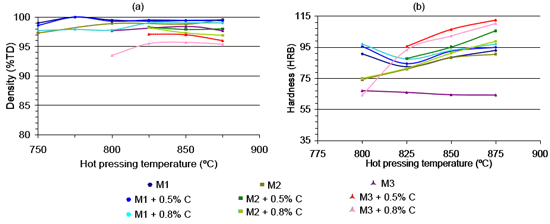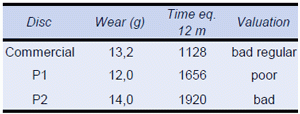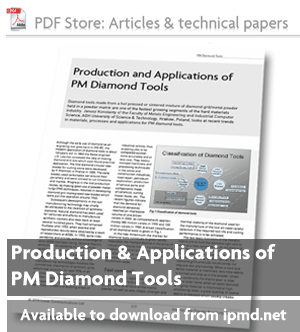Cost-effective binder phase materials for diamond tools for dry cutting applications
Dr David Whittaker reports exclusively for ipmd.net on a paper by I Iturizza, G Pena, C Luno-Bilbao and A Mancisidor (University of Navarra, Spain) and M Sarasola (Metallied Powder Solutions SA, Spain) presented at the Euro PM2011 Conference, held in Barcelona, 9-12 October, that looks at the potential use of water atomised powders in the production of such tools.
Three experimental powder mixtures (M1, M2 and M3) were prepared as base materials by blending different types of water atomised powders. All of the mixtures were based on Fe-Cu. The main alloying elements and the theoretical densities of these powder mixtures are summarised in Table 1.

Table 1 Chemical characteristics and density of the experimental powder mixtures (From paper by I. Iturizza et al, ‘Dry Cutting Diamond Impregnated Tools Based on Water Atomized Powders’ presented at Euro PM2011 Conference. Published in the Conference Proceedings by EPMA, UK)
The base materials were mixed with graphite in two different proportions: 0.5 and 0.8 wt-%. The water atomised powders were mixed in a Turbula mixer for 15 min at 30 rpm. The graphite addition was carried out in a similar manner but using a lower mixing speed of 20 rpm to avoid segregation.
The metallic powder mixtures were subsequently mixed with different quantities of synthetic diamond particles for 15 min at 20 rpm in the same Turbula mixer. Diamond granulometry was 40/50 mesh and concentration varied between C12-C14.
The powder characterisation was carried out by differential scanning calorimetry (DSC) in a calorimeter up to 1300°C in reducing atmosphere. Green compacts 6x7x20 mm3 were made by cold pressing the powder at 200 MPa pressure, achieving a green density of 70% T.D (theoretical density).
The coarse particle size of these powders in contrast to the more popular pre-alloyed or cobalt powder grades makes the use of pressure assisted methods for sintering mandatory. Hot pressing parameters ranged from 750 to 875°C, with holding times of 3 min, using vacuum/inert atmosphere.
The evolution of both density and hardness with the hot-pressing temperature has been evaluated for the different combinations of water atomised powders (Fig 1).

Fig. 1 Effect of powder consolidation temperature on density (a) and hardness (b) for the different mixtures (From paper by I. Iturizza et al, ‘Dry Cutting Diamond Impregnated Tools Based on Water Atomized Powders’ presented at Euro PM2011 Conference. Published in the Conference Proceedings by EPMA, UK)
The data in Fig. 1 confirm an excellent sinterability of the powders; 97% of the theoretical density is achieved by using temperatures as low as 800°C. Hot pressing within the temperature range 800°C – 875°C results in near fully dense materials.
The different binder compositions assessed resulted in significant increases in hardness through the studied hot pressing range, from 65 to 90-92 HRB for the Ni-Cu-Mo alloying system (M1 and M2), which proved to be more effective than the Mo-Cr system, M3. This behaviour was, however, totally changed with the addition of carbon to the mixtures. With Cr and Mo as alloying elements, the addition of graphite allows M3 to take advantage of its high hardenability, resulting, after cooling in the hot pressing cycle, in the highest hardness. The increase in hardness is associated with sintering temperatures between 825 and 875°C, where austenitisation takes place for M3+graphite, allowing strengthening through carbon diffusion in the iron based matrix.
Hardness is of relevant importance when the metallic system is considered to be used as a matrix in diamond cutting tools, because it is commonly associated with yield strength and wear resistance. The highest hardness was found at 875 °C for all the dense mixtures so this temperature was selected to process the experimental powders mixtures and to test their properties.
At this temperature, the hardness after hot pressing ranged from 90 to 112 HRB for all materials except M3 (Fig. 1). This hardness range is considered adequate for most applications of diamond tools for dry cutting.
The binder materials with better sinterability and more appropriate hardnesses have been characterised in detail in terms of their microstructure and abrasive wear resistance.
Because the results of hardness and wear resistance tests were compatible with the targeted applications, the interactions between binder phase and diamonds were then analysed.
Different mixtures have been prepared with the various binder materials and diamonds. The diamond grade used first was ISD1200, synthetic and uncoated. The specifications were grain size 40/50 mesh (297-420 m) and concentration C12, i.e. 3 vol% of diamond.

Fig. 2 Pictures of extracted diamonds after sintering at 875°C with M2 mixture (From paper by I. Iturizza et al, ‘Dry Cutting Diamond Impregnated Tools Based on Water Atomized Powders’ presented at Euro PM2011 Conference. Published in the Conference Proceedings by EPMA, UK)
These mixtures have been sintered by hot pressing at 875°C. After sintering, the colour and surface morphology of the extracted diamonds were the parameters selected to characterise diamond integrity. Fig. 2 shows the pictures of the diamond extracted from M2 mixtures and the colour change is evident. This behaviour was also observed in diamonds extracted from M1 mixtures. The more carbon content in the mixture, the less damage to the diamonds. However, diamonds processed with M3 powders did not show this appearance; all of them were black.

Table 2 Most relevant results of cutting tests (240
cuts) obtained with higher quality prototypes (From
paper by I. Iturizza et al, ‘Dry Cutting Diamond
Impregnated Tools Based on Water Atomized
Powders’ presented at Euro PM2011 Conference.
Published in the Conference Proceedings by
EPMA, UK)
Finally, prototypes with different types of diamonds were produced and tested in systematic cutting tests on granite.
The behaviour of the prototypes has been tested in trials, involving a standard of 240 cuts, with results as shown in Table 2. The results obtained were better in both, wear and cutting ability to those obtained with a commercial disc with segments based on Co.
This reported work has shown that, with a correct choice of processing conditions, it is possible to obtain a wide range of materials exhibiting an excellent combination of hardness and wear behaviour. In addition, the experimental powders can be consolidated in hot pressing conditions that guarantee minimal diamond degradation. Hence, these alloys are suitable as a matrix in diamond tools.
Further reading: Production and Applications of PM Diamond Tools
News | Articles | Market reviews | Search directory | Subscribe to e-newsletter






